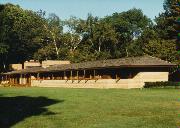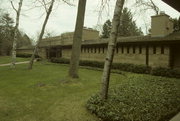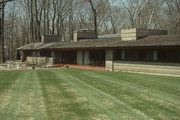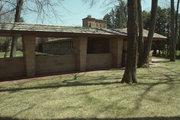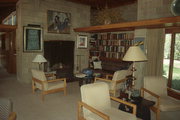Property Record
7111 N BARNETT LN
Architecture and History Inventory
| Historic Name: | Albert and Edith Adelman House |
|---|---|
| Other Name: | |
| Contributing: | |
| Reference Number: | 8661 |
| Location (Address): | 7111 N BARNETT LN |
|---|---|
| County: | Milwaukee |
| City: | Fox Point |
| Township/Village: | |
| Unincorporated Community: | |
| Town: | |
| Range: | |
| Direction: | |
| Section: | |
| Quarter Section: | |
| Quarter/Quarter Section: |
| Year Built: | 1948 |
|---|---|
| Additions: | |
| Survey Date: | 2003 |
| Historic Use: | house |
| Architectural Style: | Usonian |
| Structural System: | |
| Wall Material: | Concrete Block |
| Architect: | Frank Lloyd Wright; Claude Debbink |
| Other Buildings On Site: | |
| Demolished?: | No |
| Demolished Date: |
| National/State Register Listing Name: | Adelman, Albert and Edith, House |
|---|---|
| National Register Listing Date: | 8/26/2005 |
| State Register Listing Date: | 7/15/2005 |
| National Register Multiple Property Name: |
| Additional Information: | A 'site file' exists for this property. It contains additional information such as correspondence, newspaper clippings, or historical information. It is a public record and may be viewed in person at the Wisconsin Historical Society, Division of Historic Preservation. DESIGNED 1946. USONIAN ADAPTATION. Built for a dry-cleaning entrepreneur, the long, low-slung Adelman House recalled Frank Lloyd Wright’s 1930s Usonian designs, while looking forward to the ranch house. The Adelman residence plan forms an L, with its long axis stretching 170 feet. At the east end, three bedrooms line up along a gallery; the middle section, between broad, squat chimneys, contains an entry hall and living room; and the west end holds kitchen and dining areas. The L’s short axis is a 40-foot-long covered walkway linking the kitchen to the garage. A very low-pitched roof with wide eaves visually presses the house toward the ground. To save money, Wright built the walls of buff concrete block, which he stepped out slightly at every second course, so that the house widens as it rises. These stepped-out courses cast strong horizontal shadows. Long ribbons of casement windows, framed in cypress, accentuate the horizontality while softening the starkness of the concrete walls. Inside, built-in furniture saves space, while concrete-block walls and concrete floors, require no paint and little maintenance. To make the rooms feel warmer, Wright trimmed walls with woodwork, sheathed ceilings in wood, and exposed the beams. Full-height windows and doors in the spacious living room and window ribbons elsewhere bathe the interior in natural light. |
|---|---|
| Bibliographic References: | Buildings of Wisconsin manuscript. |
| Wisconsin Architecture and History Inventory, State Historic Preservation Office, Wisconsin Historical Society, Madison, Wisconsin |

